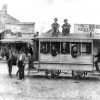calsfoundation@cals.org
C-130 Crash of 1971
Ten U.S. Air Force personnel were killed in a disastrous takeoff crash at Little Rock Air Force Base in Jacksonville (Pulaski County) on the morning of November 12, 1971, in the worst accident ever to occur at the base.
With Captain James B. Raycraft, age twenty-six, as the pilot, the C-130E Hercules taxied down the runway carrying four instructors and seven trainees on a planned flight to Fort Campbell, Kentucky, where they would “drop a 6,000 pound load module in a simulated combat drop” as the air force personnel prepared for duty in Southeast Asia.
The C-130 had traveled about 8,000 feet down the 12,000-foot runway and had reached an altitude of about 200 feet when it abruptly veered to the left and hit the ground, spinning about 180 degrees as the plane’s 40,000 pounds of jet fuel ignited. Staff Sergeant Lewis Hribar, the loadmaster, was thrown clear of the plane, though he suffered serious burns. The other ten men died in the burning plane. The Arkansas Gazette reported that, when the flames were extinguished, “only the tail section of the aircraft [was] recognizably intact.”
Colonel Richard Gibney, commander of the 314th Tactical Airlift Wing, said that “they evidently lost control,” telling reporters that “right after leaving the ground, it apparently went to the left of the runway and probably was in the process of correcting back to the runway” when the plane crashed. The crew did not make contact with the base tower before the crash.
Killed were Raycraft; navigator Captain Laurence F. Asher (age thirty-one); flight engineer Master Sergeant Orville D. Gearhart (thirty-nine); and trainees First Lieutenant Michael W. Hodge (twenty-four), Captain David C. Mourle (twenty-four), Technical Sergeant Emory V. McKee Jr. (thirty-five), Sergeant David M. Bloomberg (twenty-two), Major Paul S. Fiedler (thirty-four), Second Lieutenant William R. Gamboe (twenty-three), and Staff Sergeant William H. Dintleman (thirty-two).
Hribar suffered second-degree burns over thirty-five percent of his body and third-degree burns over nine percent of his body, but a few months after the accident, he was recovering and getting the needed skin grafts and was reported “very well and is up and around—actually walking around the hospital.”
An investigative board headed by Major General David I. Liebman was appointed to look into the accident, but the results of the study apparently were not released.
For additional information:
“10 Airmen Killed in Crash of C130 at Little Rock Base.” Times (Shreveport, Louisiana), November 13, 1971, p. 7A.
“AF Identifies Five More Dead; Survivor Moved.” Arkansas Democrat, November 13, 1971, p. 9.
“Injured Airman ‘up and around’ at Burn Center.” Arkansas Democrat, January 21, 1972, p. 5A.
Feldman, Garrick. “Sharing C-130 Crash Mementoes with Kin.” The Leader, May 25, 2021. Online at https://www.arkansasleader.come/articles/sharing-c-130-crash-mementoes-with-kin/ (accessed June 9, 2022).
Lewis, Bill. “10 Killed in Crash of C-130 at LRAFB.” Arkansas Gazette, November 13, 1971, pp. 1, 2.
Mark K. Christ
Central Arkansas Library System
 Divergent Prosperity and the Arc of Reform, 1968–2022
Divergent Prosperity and the Arc of Reform, 1968–2022 Military
Military Transportation
Transportation C-130 Crash
C-130 Crash 



I was on the flight line pre-flighting an aircraft for a flight that day. I can vividly recall the airplane, struggling to maintain altitude, and the pilot maneuvering the throttles in an attempt to avoid colliding with aircraft on the flight line. I will never forget seeing the loadmaster being taken from the crash site after being severely burned. The pilot did a great job avoiding hitting aircraft on the flight line and injuring ground crews!
I was on the wing removing a panel with another airman. His first day on duty. He was from Greenville, SC. (I live there now.) I remember the plane went over us and was making a turn to try to get back on the runway when it stalled and the right wing broke off. The young airman looked at me and asked, “Does this happen every day?”
The crash affected me and to this day I have never flown on an airplane. I was a crew chief on one of the planes.